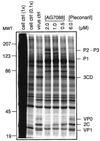In vitro antiviral activity of AG7088, a potent inhibitor of human rhinovirus 3C protease
- PMID: 10508022
- PMCID: PMC89498
- DOI: 10.1128/AAC.43.10.2444
In vitro antiviral activity of AG7088, a potent inhibitor of human rhinovirus 3C protease
Abstract
AG7088 is a potent, irreversible inhibitor of human rhinovirus (HRV) 3C protease (inactivation rate constant (k(obs)/[I]) = 1,470,000 +/- 440,000 M(-1) s(-1) for HRV 14) that was discovered by protein structure-based drug design methodologies. In H1-HeLa and MRC-5 cell protection assays, AG7088 inhibited the replication of all HRV serotypes (48 of 48) tested with a mean 50% effective concentration (EC(50)) of 0.023 microM (range, 0.003 to 0.081 microM) and a mean EC(90) of 0.082 microM (range, 0.018 to 0.261 microM) as well as that of related picornaviruses including coxsackieviruses A21 and B3, enterovirus 70, and echovirus 11. No significant reductions in the antiviral activity of AG7088 were observed when assays were performed in the presence of alpha(1)-acid glycoprotein or mucin, proteins present in nasal secretions. The 50% cytotoxic concentration of AG7088 was >1,000 microM, yielding a therapeutic index of >12,346 to >333,333. In a single-cycle, time-of-addition assay, AG7088 demonstrated antiviral activity when added up to 6 h after infection. In contrast, a compound targeting viral attachment and/or uncoating was effective only when added at the initiation of virus infection. Direct inhibition of 3C proteolytic activity in infected cells treated with AG7088 was demonstrated by sodium dodecyl sulfate-polyacrylamide gel electrophoresis analysis of radiolabeled proteins, which showed a dose-dependent accumulation of viral precursor polyproteins and reduction of processed protein products. The broad spectrum of antiviral activity of AG7088, combined with its efficacy even when added late in the virus life cycle, highlights the advantages of 3C protease as a target and suggests that AG7088 will be a promising clinical candidate.
Figures




References
-
- Arruda E, Hayden F G. Clinical studies of antiviral agents for picornaviral infections. In: Jeffries D J, De Clerq E, editors. Antiviral chemotherapy. Chichester, N.Y: John Wiley & Sons, Ltd.; 1995. pp. 321–355.
-
- Bilello J A, Bilello P A, Prichard M, Robins T, Drusano G L. Reduction of the in vitro activity of A77003, an inhibitor of human immunodeficiency virus protease, by human serum alpha-1 acid glycoprotein. J Infect Dis. 1995;171:546–551. - PubMed
MeSH terms
Substances
LinkOut - more resources
Full Text Sources
Other Literature Sources

